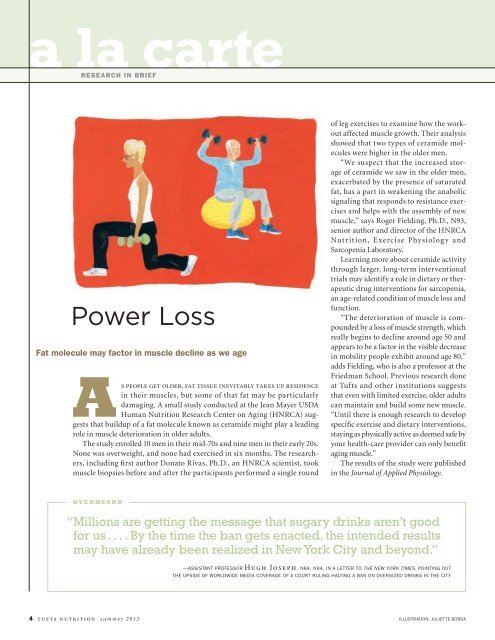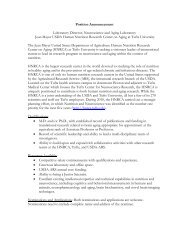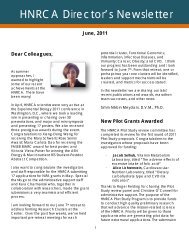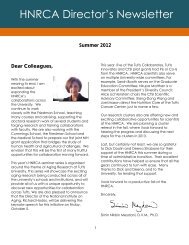Microbiome - Human Nutrition Research Center on Aging - Tufts ...
Microbiome - Human Nutrition Research Center on Aging - Tufts ...
Microbiome - Human Nutrition Research Center on Aging - Tufts ...
You also want an ePaper? Increase the reach of your titles
YUMPU automatically turns print PDFs into web optimized ePapers that Google loves.
a la carte<br />
RESEARCH IN BRIEF<br />
Power Loss<br />
Fat molecule may factor in muscle decline as we age<br />
s people get older, fat tissue inevitably takes up residence<br />
in their muscles, but some of that fat may be particularly<br />
damaging. A small study c<strong>on</strong>ducted at the Jean Mayer USDA<br />
<str<strong>on</strong>g>Human</str<strong>on</strong>g> <str<strong>on</strong>g>Nutriti<strong>on</strong></str<strong>on</strong>g> <str<strong>on</strong>g>Research</str<strong>on</strong>g> <str<strong>on</strong>g>Center</str<strong>on</strong>g> <strong>on</strong> <strong>Aging</strong> (HNRCA) suggests<br />
that buildup of a fat molecule known as ceramide might play a leading<br />
role in muscle deteriorati<strong>on</strong> in older adults.<br />
The study enrolled 10 men in their mid-70s and nine men in their early 20s.<br />
N<strong>on</strong>e was overweight, and n<strong>on</strong>e had exercised in six m<strong>on</strong>ths. The researchers,<br />
including first author D<strong>on</strong>ato Rivas, Ph.D., an HNRCA scientist, took<br />
muscle biopsies before and after the participants performed a single round<br />
of leg exercises to examine how the workout<br />
affected muscle growth. Their analysis<br />
showed that two types of ceramide molecules<br />
were higher in the older men.<br />
“We suspect that the increased storage<br />
of ceramide we saw in the older men,<br />
exacerbated by the presence of saturated<br />
fat, has a part in weakening the anabolic<br />
signaling that resp<strong>on</strong>ds to resistance exercises<br />
and helps with the assembly of new<br />
muscle,” says Roger Fielding, Ph.D., N93,<br />
senior author and director of the HNRCA<br />
<str<strong>on</strong>g>Nutriti<strong>on</strong></str<strong>on</strong>g>, Exercise Physiology and<br />
Sarcopenia Laboratory.<br />
Learning more about ceramide activity<br />
through larger, l<strong>on</strong>g-term interventi<strong>on</strong>al<br />
trials may identify a role in dietary or therapeutic<br />
drug interventi<strong>on</strong>s for sarcopenia,<br />
an age-related c<strong>on</strong>diti<strong>on</strong> of muscle loss and<br />
functi<strong>on</strong>.<br />
“The deteriorati<strong>on</strong> of muscle is compounded<br />
by a loss of muscle strength, which<br />
really begins to decline around age 50 and<br />
appears to be a factor in the visible decrease<br />
in mobility people exhibit around age 80,”<br />
adds Fielding, who is also a professor at the<br />
Friedman School. Previous research d<strong>on</strong>e<br />
at <strong>Tufts</strong> and other instituti<strong>on</strong>s suggests<br />
that even with limited exercise, older adults<br />
can maintain and build some new muscle.<br />
“Until there is enough research to develop<br />
specific exercise and dietary interventi<strong>on</strong>s,<br />
staying as physically active as deemed safe by<br />
your health-care provider can <strong>on</strong>ly benefit<br />
aging muscle.”<br />
The results of the study were published<br />
in the Journal of Applied Physiology.<br />
OVERHEARD<br />
“Milli<strong>on</strong>s are getting the message that sugary drinks aren’t good<br />
for us . . . . By the time the ban gets enacted, the intended results<br />
may have already been realized in New York City and bey<strong>on</strong>d.”<br />
—ASSISTANT PROFESSOR Hugh Joseph, N84, N94, IN A LETTER TO THE NEW YORK TIMES, POINTING OUT<br />
THE UPSIDE OF WORLDWIDE MEDIA COVERAGE OF A COURT RULING HALTING A BAN ON OVERSIZED DRINKS IN THE CITY<br />
4 tufts nutriti<strong>on</strong> summer 2013<br />
ILLUSTRATION: JULIETTE BORDA







